12 False Facts About Pork You Thought Were True

We may receive a commission on purchases made from links.
Pork is one of the most popular meats in the United States, both in terms of production and consumption. Despite the meat's ubiquity, there are many false facts surrounding pork's nutritional value, production, and means of preparation. The majority of these myths stem from outdated practices and information that have little or no relevance to modern kitchens and food systems, yet they continue to impact how pork is consumed today.
Dispelling these false facts and modernizing your view of pork will bring numerous benefits to your cooking. Not only will it prevent you from committing age-old mistakes such as overcooking, but it will also allow you to identify and purchase more flavorful meat. What's more, improving your knowledge of pork means you can be cognisant of the impact it has on your health.
While practical, the information in this article reaches beyond the kitchen. After dispelling the false facts surrounding pork you will be able to make informed decisions that have a wide-reaching impact on animal welfare and national food systems. As journalist Barry Estabrook explained to Civil Eats, "pork is either the best meat–from the perspective of the environment, animal welfare, labor justice, etc. — or the worst. Many of us have a choice." This article will ensure your choice is the right one.
Read more: 11 Things You Didn't Know You Should Be Doing With Bacon
False: All Pork Is High In Fat
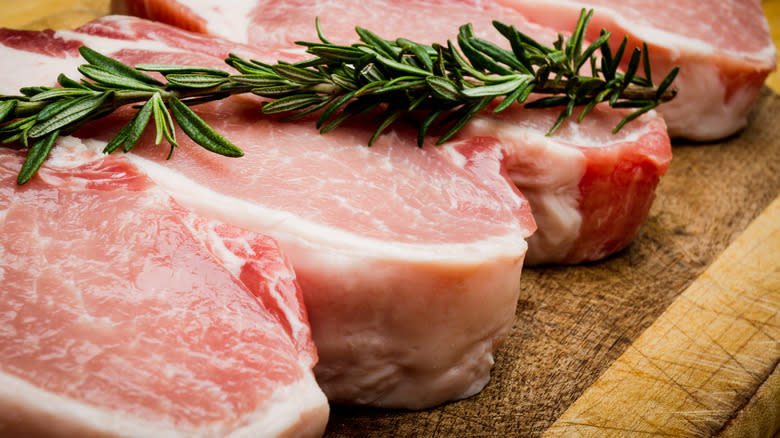
Pigs have long been viewed as fat creatures. This fact is evidenced in the English language; calling someone a pig is akin to labeling them a glutton and porky is just another word for overweight. The reason for the pig's fatty reputation is simply that pigs used to be fat animals.
In recent decades, however, breeding practices and farming policies have caused pigs to become increasingly lean. In 2020, it was reported that the average pig in the U.K. had a body fat percentage of 16%. At the time, this was a lower body fat percentage than that of the average British human. The U.S. has seen a similar trend occurring, with pigs getting leaner and more muscular due to fears surrounding fat consumption and the demand for high and efficient meat yields.
While modern pigs are much leaner than they used to be, some cuts of pork remain fatty. This is because a pig's fat is not equally distributed around the body. Pork belly is among the fattiest cuts, containing 14.8 grams of fat per ounce. Other cuts are incredibly lean, including pork chops which contain as little as 1.76 grams of fat in each ounce served. Pork tenderloins are even leaner and contain less fat than skinless chicken breasts.
False: Pork Lacks Flavor

The dramatic reduction in pork's fat content has had a pronounced impact on its flavor. In the present day, many Americans describe pork as bland, likening it to chicken breasts. While it is fair to describe the vast majority of American pork in this way, not all pork lacks flavor.
Fatty, flavorful pigs are still reared by farmers across the country. Many of these farmers choose to rear heritage breeds — animals that have not been bred for leanness and efficiency but rather to maintain their unique genetic make-up and associated fat-storing capabilities. A great example of this is the Berkshire which is a fat pig that produces extremely flavorful and heavily marbled meat.
The difference in taste between pork from these heritage animals and lean, commercially-bred pigs is astounding. Speaking to The Michelin Guide about the Mangalitsa, a high-fat heritage pig from Hungary, chef Jenő Rácz said, "It's highly marbled, rich in flavour, and has a unique taste that sets it apart from conventional pork. The meat is succulent, tender and offers a melt-in-your-mouth experience." So while it's fair to say most pork now lacks flavor, not all of it does.
False: Pork Is A White Meat
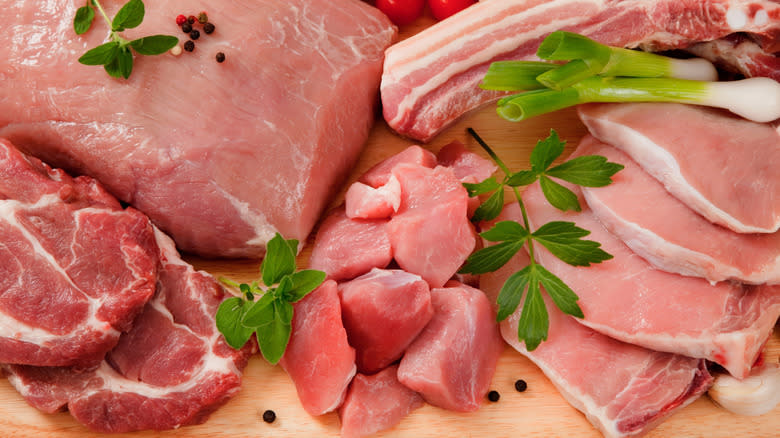
In 1987, the National Pork Board released an advertising slogan that read: "Pork. The Other White Meat." This slogan was designed to create associations between pork and chicken, a meat that was rapidly gaining popularity at that time, and it was incredibly successful, remaining in use for 24 years. Despite being discontinued in 2011, the National Pork Board's slogan had a huge effect on how many Americans view pork, with a significant proportion actually believing it is a white meat.
From a scientific standpoint, pork is a red meat. This is because it contains more myoglobin — a type of protein — than chicken and fish. What's more, pigs are mammals and any protein that comes from a mammal is defined by The United States Department of Agriculture as red meat.
While pork is always classified as a red meat, and chicken and turkey as white, the division is somewhat nebulous. This is because different cuts of the animals contain varying amounts of myoglobin. For example, dark meat found on poultry can contain more myoglobin than pork tenderloin. This makes consumer confusion all the more understandable.
False: Consuming Bacon Greatly Increases Your Risk Of Cancer
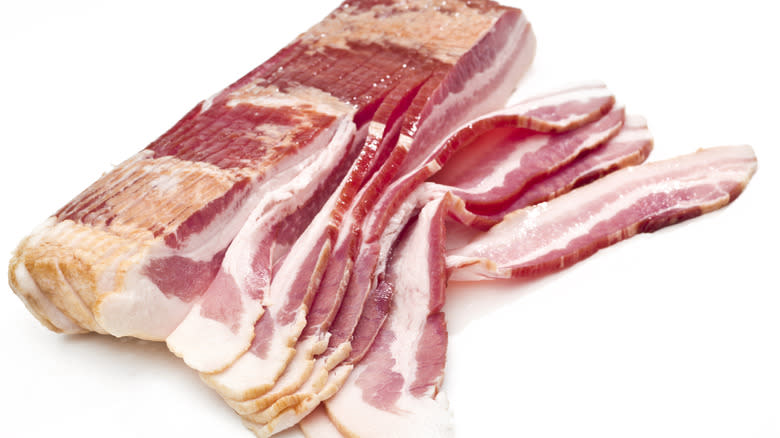
It's often repeated that bacon causes cancer. In some ways, this is true. The nitrites and nitrates used to preserve bacon and other processed meats have been shown to increase the risk of certain types of cancer developing if consumed regularly. However, the degree to which bacon and other processed meats contribute to the chances of cancer is often greatly exaggerated; Forbes highlighted that consuming 50 grams (about two slices) of bacon a day is only going to increase an individual's risk of developing bowel cancer by about 1%.
The cancer risk associated with bacon consumption is significantly less than that posed by other diet-related lifestyle choices. Professor Tim Key explained this to Cancer Research UK, saying, "The most important diet related risk factors for cancer are obesity and alcohol, which both increase risk of many types of cancer, and cause more cases than red and processed meat."
Given that nitrites have been shown to increase the risk of certain cancers, it's no surprise that nitrite-free bacon has found a place on the market. This bacon is not cured with nitrite. Instead, it uses a marinade which often includes celery juice. Celery juice contains a great deal of nitrites itself which means that even nitrite-free bacon contains these carcinogenic compounds. As a result, those seeking to greatly reduce their nitrite consumption while still eating bacon should only buy bacon that's been cured in the traditional manner using salt alone.
False: Pork Must Be Cooked More Than Other Meats
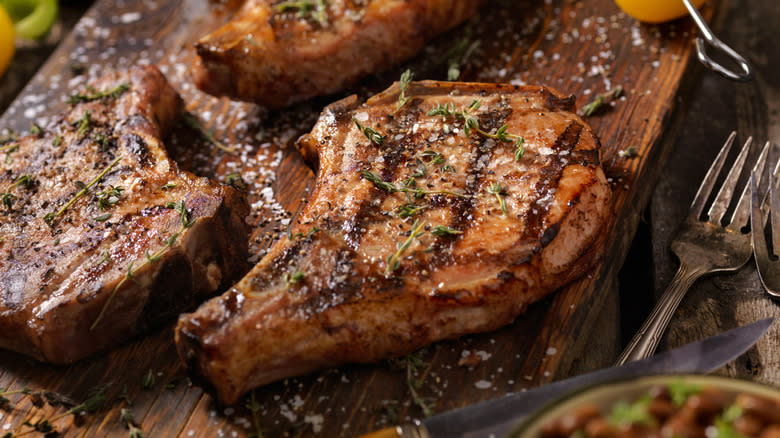
The vast majority of Americans overcook pork. This practice stems from the belief that raw pork is riddled with a type of roundworm called Trichinella spiralis, a parasite that causes an illness known as trichinosis. However, modern farming practices have meant that cases of trichinosis caused by pork are incredibly rare. Despite this, the United States Department of Agriculture still advises cooking pork to a minimum internal temperature of 145 degrees Fahrenheit.
As a lean meat, cooking pork to this temperature leads it to become dry and unpalatable. For this reason, many chefs advocate for cooking the meat less and allowing it to remain somewhat pink. Some chefs even serve pork raw, claiming it has a far superior eating experience. Speaking to Serious Eats, chef Cosmo Goss explained, "if it's the right cut, it has great flavor. I feel that you can feel the fat better in your mouth when pork is raw. When the pork quality is really top-notch, the fat should have a buttery consistency to it."
Other types of meat — particularly game — are much more likely to contain Trichinella spiralis than commercial pork, and yet these meats are not held to the same rigorous cooking standards. Eating rare to medium-rare pork is not the danger-ridden practice many believe it to be. For those willing to cook the pork less than the USDA advises, a juicy, flavorful piece of meat is the reward.
False: Cooking Is The Only Way To Prepare Pork
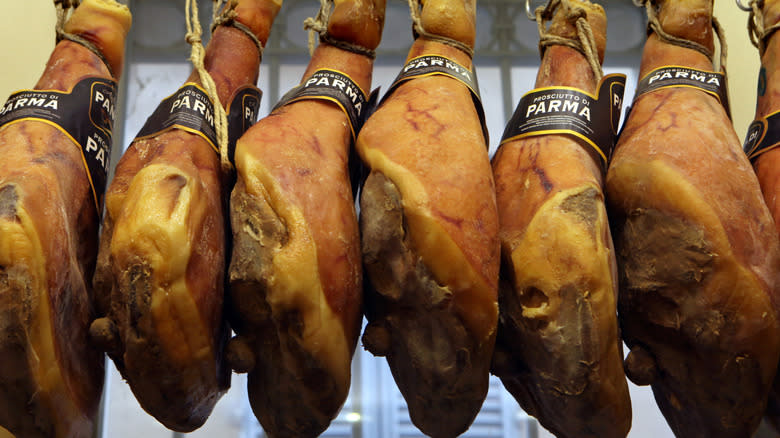
Although there are widespread (and slightly misplaced) fears about pork's ability to carry parasites and foodborne illnesses, many Americans consume uncooked pork on a regular basis. This pork is in the form of prosciutto, a product that is never frozen or cooked, but cured by covering it with salt before aging it for extended periods of time. The salty, dry nature of the meat inhibits bacterial growth, ensuring prosciutto remains safe for human consumption.
In many cultures, hanging and drying your own meat remains a commonplace practice. In the United States, however, doing so is viewed as a niche hobby. That being said, excellent prosciutto can and is being made within the U.S., as was highlighted to Italy Magazine by Herb Eckhouse, a prosciutto producer based in Iowa. "All of our Italian associates said that we would not be able to make good quality prosciutto in the U.S. — the pork would not be right, the air would not be right," Eckhouse said about his start in curing the meat, noting, "In fact, it is possible."
False: All Sausages Contain Pork

Pork is frequently used in sausages as certain cuts, such as pork butt, naturally contain the perfect fat-to-meat ratio. However, the prevalence of pork sausages has led people to falsely assume that many popular types of sausage include pork. This is most readily evidenced by hot dogs which, contrary to common belief, are routinely made with beef or chicken instead of pork.
Even traditional pork sausages, such as salami, can be made from other types of meat. Among the most popular of these are beef salamis which have been made for those following kosher diets. An example of a kosher, beef salami is the All Beef Kosher Sausage from A & H. While pork-free, this product carries the traditional flavor of salami, as highlighted by a review left on the A & H website: "Since attempting to follow the laws of kashrut I have been searching for a salami with the flavor I have been missing [...] The beef salami has the right texture, not dry and has a fantastic flavor."
False: Pork Contains Few Nutrients
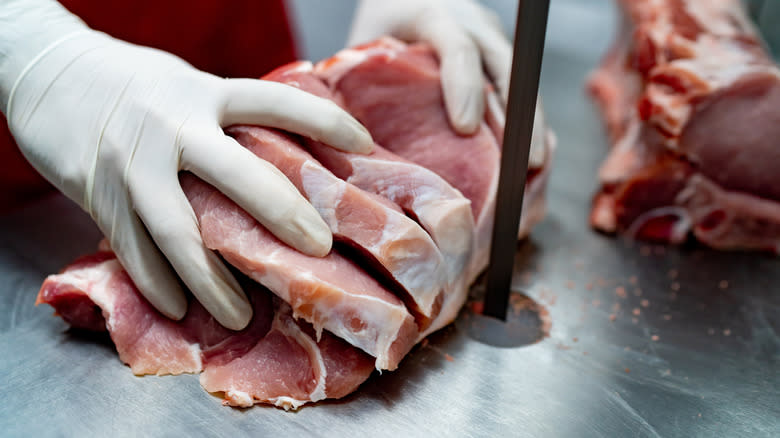
Aside from supposedly being high in unhealthy fats, another common criticism of pork is that it contains few nutrients. This is not true. In fact, pork contains significant amounts of several nutrients. When it comes to protein, ground pork contains 17.8 grams per 100-gram serving. That's only 0.1 grams less than found in the same serving of chicken and 0.3 grams more than in ground beef.
Pork is also a great source of zinc, selenium, and vitamins B6 and B12. Thanks to the concentration of these nutrients and others, pork is generally believed to be more nutrient-dense than beef. Such a strong nutritional profile means that pork, like most other meats, can form part of a healthy balanced diet as long as consumers eat a variety of pork cuts. Failure to do so could see an overindulgence on fatty pork cuts, which would ultimately have a negative impact on health.
False: Most Pigs Are Reared In A Humane Manner
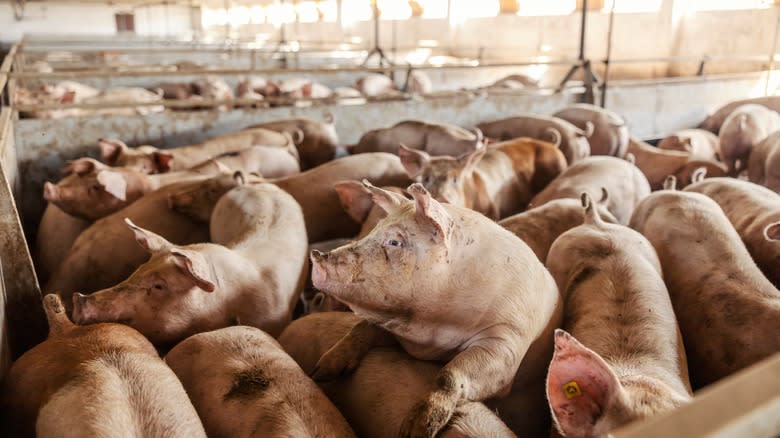
According to the ASPCA, the overwhelming majority of all United States pigs are reared in large-scale, commercial factory farms. These sprawling farms often employ less-than-stellar practices, as was evidenced by an investigation performed by the animal welfare activist group, Animal Outlook. In a report and video released online, they revealed horrifying practices at commercial, American pig farms. These included physical abuse of the animals and terrible hygiene practices including feeding the intestines of dead and diseased piglets to other pigs. Daniel Waltz, managing attorney for Animal Legal Defense Fund, said to Vox, "If the practices shown on Animal Outlook's undercover investigations are just the practices that all farmers do, I can't think of a worse indictment of the animal agriculture industry. The undercover investigation [...] showed all sorts of cruelty."
Even at factory farms that don't commit such atrocities, the use of inhumane pieces of equipment, such as gestation crates, remains rife. It's estimated that in 2026, after years of campaigning, only 6% of U.S. hogs will be legally protected from the use of gestation crates.
The terrible conditions found at many of these industrial pig farms also have a hugely detrimental impact on local communities. In some parts of North Carolina, vast amounts of pig feces and other bodily excrement and fluids are stored in open lakes, filling the air with a putrid stench. Disproportionately affecting poor, Black communities, the waste of factory pig farms has been deemed environmental racism.
False: Pigs Are Dumb And Dirty
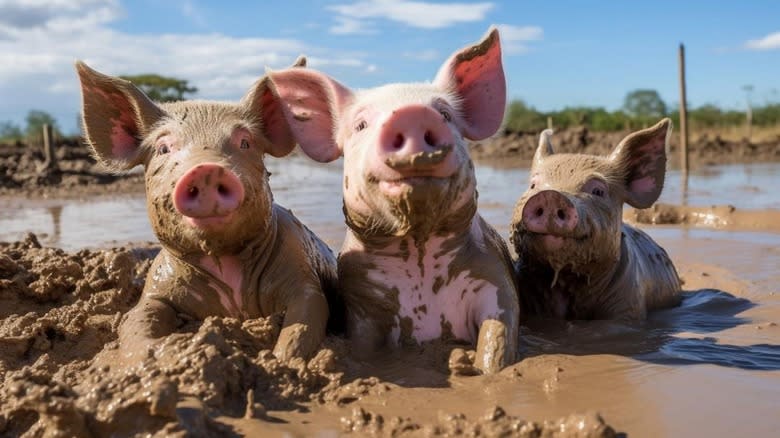
Across cultures, pigs are derided as dirty and dumb animals. This is far from the truth. Pigs are actually extremely intelligent creatures. They're smarter than dogs and have shown superior intelligence to three-year-old humans. What's more, pigs have proven to be empathetic and will try to help other pigs that are in distress. In terms of cleanliness, our perception of pigs is also wrong. The animals are hygienic — they create specific places where they dispose of their waste to keep the rest of their living area clean.
The view that pigs are unclean probably arose due to their notorious eating habits — pigs will eat a variety of things, including excrement (although they're not the only animals to do this). It is also to do with their practice of covering themselves with mud. This, however, is a natural process pigs undertake to avoid sunburn.
It's hypothesized that the myth of pigs being dumb has been sustained because believing it makes it easier for humans to treat pigs so poorly. Intensive, abusive farming practices would be much harder for the public to swallow if pigs were viewed in the same light as dogs and other household animals. As a result, it's unlikely that our perception of pigs will change as long as we continue to farm them in such an abhorrent manner.
False: Pork Is Not As Popular As Other Meats

The United States is often viewed as a nation of beef eaters, but according to Statista, the average American consumed almost as much pork as they did beef in 2022. Furthermore, per capita pork consumption is projected to outstrip beef consumption in the United States by as soon as 2032. This would make it the second most consumed animal protein in the U.S. behind chicken.
The upward trend in American pork consumption reflects the huge global demand for pork. The United Nations Food and Agriculture Organization claims that pork is the most widely eaten meat in the world accounting for 36% of the total. This figure dismisses the myth that pork is not as popular as other meats.
Although pork is eaten widely, consumption of it does vary across the U.S. The Midwest and the South are the biggest pork-consuming areas in the country with an annual per capita consumption of 58 and 53 pounds respectively. There are also racial differences in pork consumption. On average, Black Americans eat 63 pounds of pork annually. By comparison, the average white American consumes 49 pounds of pork per year. Hispanic Americans have the lowest average with 45 pounds.
False: All Pork Comes From The Same Type Of Pig
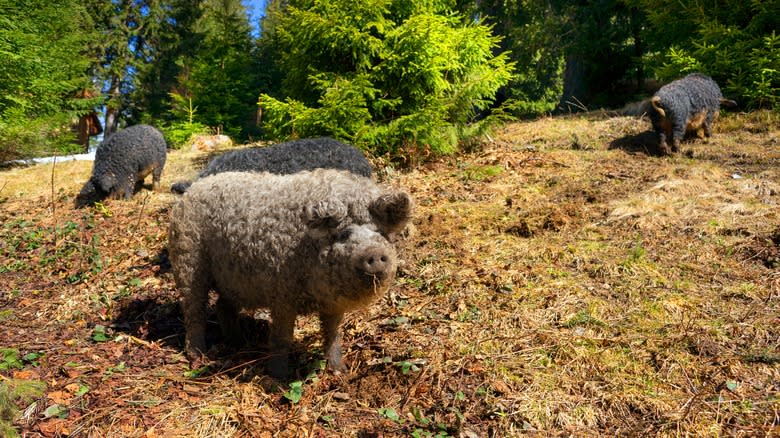
The vast majority of pork found in American grocery stores comes from one of four breeds: Duroc, Hampshire, Landrace, and Yorkshire. These are known for being lean, durable breeds that perfectly suit a food system prioritizing cheap, flavorless, and lean protein. As all this grocery store pork tastes and appears the same, many customers are not aware that their meat comes from a variety of breeds. Even fewer people are aware that there are a number of other breeds which promise meat of greater quality and flavor.
This meat comes from heritage breeds that are often raised on pasture by small farmers. This means that, aside from their higher fat concentration, these pigs have the added benefit of natural, healthy lives. This is evidenced in the quality of the meat. When asked what his initial response to eating pasture-raised heritage pork was, Barry Estabrook said to Modern Farmer, "I was blown away. I absolutely had no idea that any pork could taste so good and be so different than 'the other white meat.'"
Thankfully, Americans have plenty of heritage breeds to choose from including the Red Wattle, Tamworth, and Gloucester Old Spots pigs. Each boasts its own characteristics, but all are superior to mass-produced commercial pork. While not often stocked in large grocery stores, pork from these heritage breeds can be purchased at butcher shops and online.
Read the original article on Daily Meal.

